- Understanding the Wholesale Diamond Market
- Benefits of Purchasing Diamonds at Wholesale Prices
- Essential Diamond Knowledge Before You Buy
- How to Buy Diamonds Wholesale: Step-by-Step Process
- Finding Reputable Wholesale Diamond Suppliers
- Buying Diamonds in Bulk: Strategies and Considerations
- Wholesale Diamond Industry Secrets Revealed
- Special Diamond Types: Are They Worth Buying Wholesale?
- Legal and Ethical Considerations in Wholesale Diamond Purchasing
- Common Pitfalls to Avoid When Buying Wholesale Diamonds
- Best Practices for Wholesale Diamond Purchases
- Conclusion: Mastering the Art of Wholesale Diamond Buying
- FAQ
- Source Links
How to Buy Diamonds Wholesale: Samantha visited a fancy jewelry store and spotted a 1.50 CT GIA-certified round diamond priced at $18,000. The salesperson claimed it was a great deal, but is retail the smartest choice?
Understanding how to buy diamonds wholesale can help you save significantly by cutting out retail markups and purchasing diamonds at fair market value. Before investing, it’s crucial to research certifications, wholesale sources, and pricing strategies to get the best deal.
But then, she found Lumera’s website. It had the same diamond for $10,860. This made her very surprised.
Doubting how to buy diamonds wholesale without overpaying? This guide interruptions down everything you need to know.
Both stores paid $10,000 for the diamond. But, the traditional store charged $8,000 more. Lumera’s online model only charged $450. This shows big savings when buying outside traditional stores.
Key Takeaways
- Wholesale diamond buying guide reveals price gaps like $7,140 between retail and wholesale for the same 1.50 ct GIA diamond
- Traditional jewelers add up to 100% markup compared to Lumera’s under 9% premium
- GIA certifications ensure authenticity through unique identification numbers
- Finer Jewelry offers customizable designs while lab-grown options expand affordability
- Buying in bulk can save up to 20% on loose diamonds
Understanding the Wholesale Diamond Market
Learning about how to buy diamonds starts with knowing what’s real. Many think “wholesale” means big discounts online. But, the real story is in the hidden parts of the supply chain.
Considering lab-grown diamonds for your wholesale purchase? These gems offer a supportable and profitable different to mined diamonds.
To explore deeper into the benefits and thoughts of lab-grown diamonds, explore our complete guide: Discover The 4 Best Lab Grown Diamonds – Find Now. This resource provides insights into ethical sourcing, customization options, and smart shopping strategies to help you make informed decisions in the wholesale market.
“Wholesale is the purchase of large quantities of goods for eventual resale,” highlighting its core distinction from consumer transactions.
What “Wholesale” Really Means in the Diamond Industry
Getting into wholesale diamonds is tough. Stores like Tiffany sell rings for $2,000, starting with rough stones from De Beers and Al Rosa. To buy from De Beers, you need to pay millions first.
Only deals over $5,000 are wholesale. They are tax-free and meant for selling again. This is different from buying one stone at a time.
The Difference Between Retail and Wholesale Prices
- Retailers markups average 160-300% of cost
- Wholesale profit margins hover at 5%, with miners needing 30-40% margins to profit
- Online platforms like Blue Nile undercut traditional stores by eliminating brick-and-mortar costs
Key Players in the Wholesale Diamond Supply Chain
The industry has four main parts:
- Miners: De Beers (Botswana mines) and Al Rosa (Russia’s Sakha Republic)
- Processors: Surat’s 3,000+ cutting factories handle 90% of global polishing
- Traders: Antwerp’s bourses and Mumbai’s diamond bazaars set global benchmarks
- retailers: Stuller supplies jewelers, while Tiffany adds 200% markup for branding
Knowing this chain is key to wholesale diamond industry secrets. It helps in purchasing diamonds at wholesale prices. Buyers must understand this complex world where many retailers face low profit margins.
Benefits of Purchasing Diamonds at Wholesale Prices
Buying diamonds at wholesale prices saves a lot of money. Retail prices have extra costs for stores, ads, and profits. Wholesale markets let buyers save up to 70% on quality stones.
“The average markup on a GIA certified Lumera diamond is less than 9%, compared to 100% or more at traditional jewelers,” highlighting the gap between wholesale and retail pricing.
Key advantages include:
- Cost savings: Cutting out middlemen saves money, with loose certified diamonds 20-50% cheaper than retail.
- Increased selection: Wholesalers have rare cuts and I3 clarity options not found in most stores.
- Custom options: Designers can make unique jewelry with loose stones, saving 30-50% compared to pre-set pieces.
| Category | Wholesale Benefits | Retail Limitations |
|---|---|---|
| Price | Up to 70% savings | Markups up to 100% |
| Certification | 90%+ GIA certified stones | Variable certification standards |
| Selection | Thousands of loose options | Limited in-store inventory |
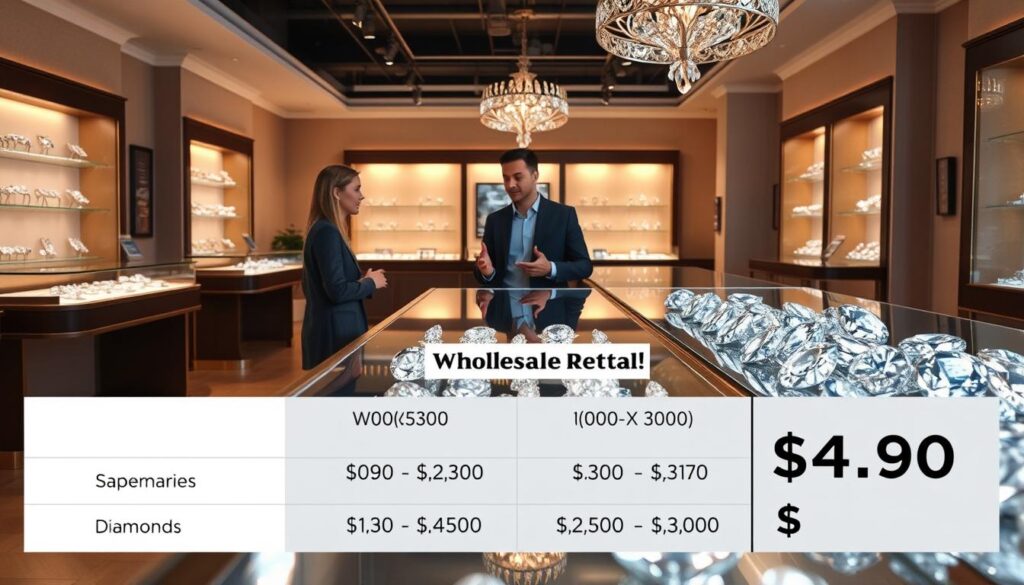
Lab-created CVD diamonds are 30-50% cheaper than mined ones. They have the same clarity and color. Shira Diamonds offers these with gemologist support.
One of the smartest ways to save money on jewelry is learning how to buy diamonds wholesale like a pro. For those who care about the environment, CVD diamonds are 90% better than mining.
Essential Diamond Knowledge Before You Buy
Learning about diamonds is key to smart buying. Start with the 4Cs and look for certifications.
How to Buy Diamonds Wholesale: Buying diamonds at wholesale prices can be a smart way to save money while still getting top-quality stones. Wholesale buyers have access to certified diamonds at lower costs, making it essential to understand how the process works and where to find trusted sources. This helps you find good deals and avoid spending too much. Here’s how to understand quality and price:
The 4Cs: Cut, Color, Clarity, and Carat
| Aspect | Key Tips |
|---|---|
| Cut | Excellent cuts cost 15–20% more than Very Good grades but deliver maximum sparkle. |
| Color | H-J colors save up to 42% vs. G, with no noticeable yellow tint. |
| Clarity | VS1-VS2 grades are eye-clean and cost less than Flawless or VVS options. |
| Carat | Opt for 0.9ct instead of 1ct to save 20% while keeping visual appeal. |
Diamond Certifications and Why They Matter
Always ask for a GIA or AGS certificate. Stay away from IGI or EGL reports. They might make diamonds seem better than they are. A certified report means you’re paying for what you see.
Understanding Diamond Grading Reports
Before making a big purchase, know the ins and outs of how to buy diamonds wholesale safely and smartly
- Verify fluorescence: None or Faint is ideal
- Check symmetry and polish ratings
- Confirm the lab’s name (GIA preferred)
Common Diamond Shapes and Their Value Differences
Rounded cushion cuts are 15–20% cheaper than round brilliants but offer similar brilliance. For elongated cushion cuts, look at sellers like James Allen or Blue Nile for certified inventory. When looking for where to buy elongated cushion cut diamond, compare lab-graded options. This ensures the shape fits your budget.
Knowing about shapes and the 4Cs makes buying diamonds a smart move. Always check lab reports and compare certified listings across platforms.
How to Buy Diamonds Wholesale: Step-by-Step Process
How to Buy Diamonds Wholesale: Buying diamonds at wholesale prices can be a smart way to save money while still getting top-quality stones. Wholesale buyers have access to certified diamonds at lower costs, making it essential to understand how the process works and where to find trusted sources.
Many beginners ask how to buy diamonds wholesale—the process may seem tricky, but it’s easier with the right tips.
It needs careful steps. First, get the right papers. You need a business license, tax ID, and proof of being in the industry.
Individuals can join groups to find suppliers. This helps a lot.
“To buy from De Beers, you must be a sight holder (Global Sight holder Sales), which alone could cost millions.”
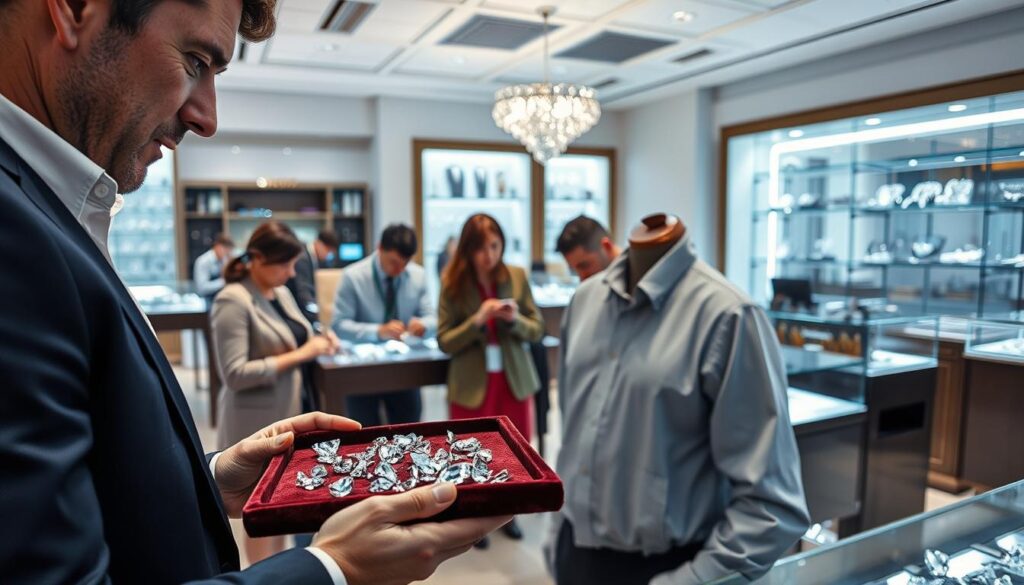
It’s important to make connections. Go to trade events like JCK Las Vegas. Or visit places like New York’s 47th Street or Antwerp’s Hogestraat.
Online sites like RapNet and Diamond Matrix help too. They connect buyers with diamond wholesale suppliers. Knowing brokers who can help is also good.
Showing you know what you’re doing is key. Be clear when asking for prices. Mention carat, clarity, and cut. Ask for lab reports from places like GIA or AGS.
Don’t ask for “good quality” stuff. Suppliers like specific details.
- Check if suppliers are certified and part of the World Diamond Council.
- Ask for small orders or samples to see if they’re reliable.
- Get references from other buyers in your area.
Most buyers want to make sure the diamonds are good. Always ask for grading reports. By following these steps, you can save 30-50% on diamonds. Being ready and persistent helps a lot in this market.
Finding Reputable Wholesale Diamond Suppliers
Start by looking at places like Antwerp, Mumbai, and New York for diamond suppliers. These spots have lots of businesses and certified stones.
Antwerp alone sees 80% of global rough diamonds, are often found here.
“At Israel Diamonds, we ensure every stone reflects nature’s clarity, any artificial treatments,” emphasizes their commitment to authenticity.
First, visit big trading areas:
- Antwerp’s Diamond District for historic expertise
- Mumbai’s cutting centers for smaller stones
- New York’s 47th Street for direct retailer access
Online sites like Repents and IDEX help find how to buy diamonds wholesale. They need business info but show global options. Sites like Lumera offer certified stones at 9% markup, skipping the 100% markups.
Use this checklist to check suppliers:
- Check for GIA certifications and grading reports
- Ask for references from past clients
- Make sure they belong to groups like the World Federation of Diamond Bourses
Always ask about treatments and grading. Stay away from unclear pricing or missing info. Choose those with GIA-certified stones for real value and authenticity.
Buying Diamonds in Bulk: Strategies and Considerations
Buying diamonds in bulk can save money. First, decide on what you want with clear 4Cs. This means setting color grades within ±1 step for consistency.
Before making a big purchase, know the ins and outs of how to buy diamonds wholesale safely and smartly.
Also, set a minimum number of stones. Most suppliers need 5–10+ stones for discounts. Use tools like microscopes and spectrometers to check each stone. Then, log the details in inventory systems for easy tracking.
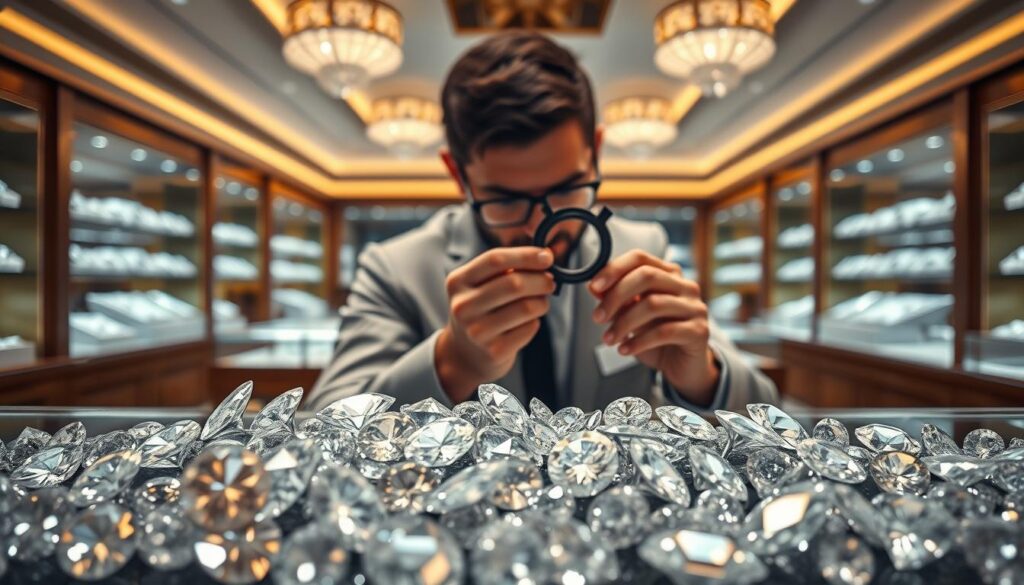
There are different financing options. Memo arrangements let you get stones without paying first. Consignment deals also reduce risk.
Make sure to insure stones during transport and storage. This protects your valuable inventory. Also, buying in places like the UAE (0% VAT) or Belgium (low markup zones) can save money.
| Region | Key Advantage |
|---|---|
| UAE | No VAT on diamonds |
| Antwerp | Global trading hub with competitive pricing |
| India | Lower overheads enable 1–15% wholesale margins |
When buying wholesale, try negotiating tiered pricing. Larger orders can get 10–20% discounts. Work with suppliers like Blue Nile or Madore for online deals.
Keep an eye on regional markets. Dubai and Antwerp have 30–40% lower prices than European cities with 25% VAT.
- Require grading reports from GIA or IGI for each batch
- Track carat weight milestones—prices jump at 1ct, 2ct thresholds
- Use blockchain platforms to verify ethical sourcing
Always talk to legal advisors about import/export rules. Buying in bulk can cut costs by 20–30% with the right partnerships and research.
Wholesale Diamond Industry Secrets Revealed
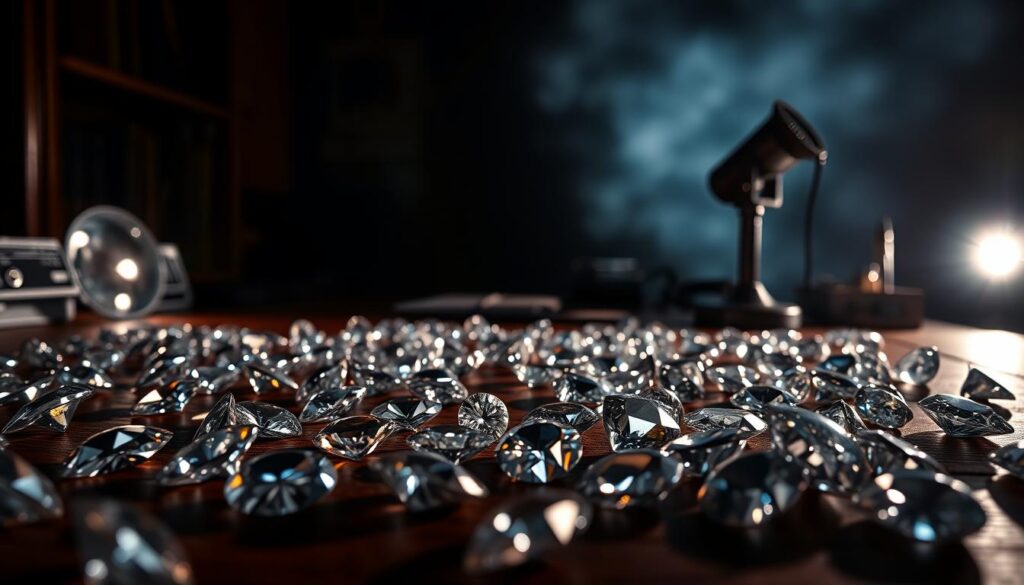
Learn the wholesale diamond industry secrets to beat the game. It’s not just about the price. It’s about getting the best deal at the right time. Know the Rapaport Price List, the key to wholesale rates.
One of the smartest ways to save money on jewelry is learning how to buy diamonds wholesale like a pro.
Deals can be 15-30% off Rap prices. But, watch out for extra costs like certification or import duties. Wholesale diamond purchasing tips say to ask for total costs upfront to avoid surprises.
“Patience and timing are your best tools. Wait until after trade shows to find motivated sellers,” says a 20-year industry insider with hands-on experience sorting thousands of diamonds.
Seasonal times offer great savings. Buy after trade shows or in late Q1 when sales slow. Year-end is also good for deals as dealers clear out old stock. How to Buy Diamonds Wholesale: Buying diamonds at wholesale prices can be a smart way to save money while still getting top-quality stones.
Wholesale buyers have access to certified diamonds at lower costs, making it essential to understand how the process works and where to find trusted sources.
How to Buy Diamonds Wholesale Learning the stylish practices for buying diamonds noncommercial can help you secure better deals on high- value monuments. With noncommercial buying, you skip retail cheapies and get near to true diamond value.
Use smart negotiation tactics. Always ask for discounts based on percentages, not fixed prices. Buying in bulk and paying in cash can also help. Don’t rush—show you know your worth.
- Hidden Fees: Certification, shipping, and import duties
- Seasonal Sweet Spots: Post-trade shows, January-March, December
- Power Moves: Cash payments, bulk orders, percentage-based negotiation
With these wholesale diamond industry secrets, even new buyers can get great deals. For example, a 1.5ct diamond for $10,860 instead of high retail prices. Timing, knowledge, and confidence make these strategies work.
Special Diamond Types: Are They Worth Buying Wholesale?
Wholesale buyers look at special options like elongated cushion cuts and I3 clarity stones. These choices offer unique chances but need careful thought. Two big questions are: where to buy elongated cushion cut diamond and are i3 diamonds worth buying? Let’s look at their value.

Elongated Cushion Cut Diamonds: Value and Availability
Elongated cushion cuts mix the sparkle of classic cuts with a modern shape. They have 1.15:1 to 1.30:1 ratios, making them great for engagement rings. Look for them on wholesale sites like RapNet or in New York’s 47th Street. Make sure sellers have GIA certifications to check the cut quality.
- Verify cut ratios using grading reports
- Compare prices across RapNet and local diamond districts
- Look for suppliers with bulk discounts on certified lots
I3 Diamonds: Understanding Low Clarity Wholesale Options
I3 diamonds have big flaws that you can see without a magnifier. Are i3 diamonds worth buying? They’re cheap, good for industrial use or budget jewelry. Retailers don’t like them, but wholesale buyers might find deals for custom pieces. Most I3 stones are used for industrial purposes, not jewelry.
How to Buy Diamonds Wholesale Wholesale diamond purchasing gives buyers the occasion to pierce decoration diamonds at reduced costs. By sourcing from pukka wholesalers, you can get superior quality without overpaying.
- I3 clarity means visible inclusions at eye level
- Use in settings with metal coverage to hide flaws
- Compare prices against higher clarity stones for savings
Wholesale buyers need to think carefully about these choices. Unique cuts and low-clarity stones need smart planning to fit your project.
Legal and Ethical Considerations in Wholesale Diamond Purchasing
When buying diamonds wholesale, always check the law. Look for Kimberley Process certificates on every shipment. De Beers Group, a big name, makes sure their mines in Botswana and Canada follow strict rules.
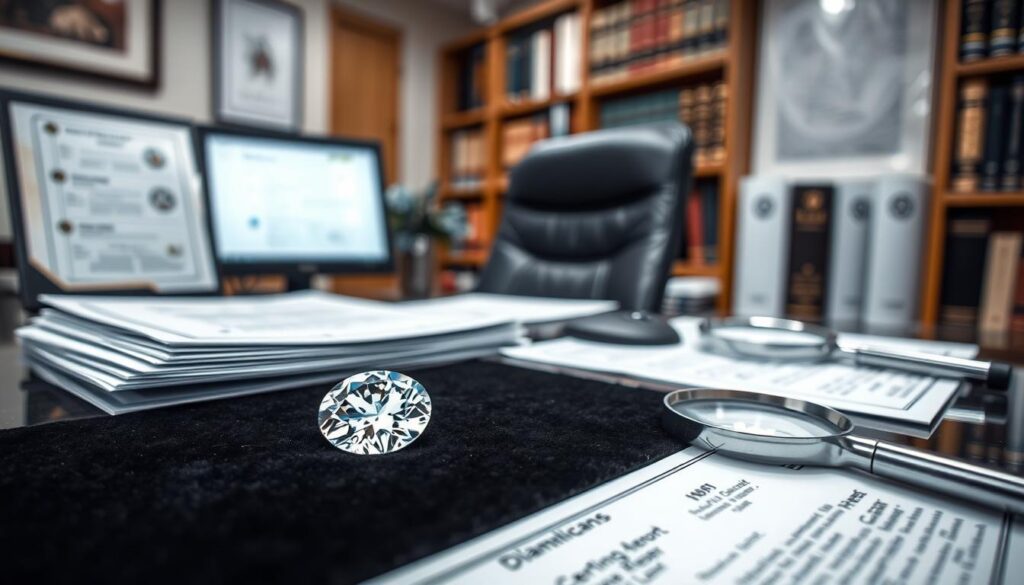
Does Wedding Day Diamonds buy jewelry? Check their sourcing policies—they must avoid artisanal mines with child labor issues. Over 1 million African miners earn under $1 daily, per industry reports.
How to Buy Diamonds Wholesale Understanding the noncommercial diamond request can help you save plutocrat and avoid paying retail cheapies. By copping
diamonds directly from trusted wholesalers, you gain access to high- quality, pukka monuments at competitive prices.
Here are some important steps to follow:
- Verify OECD due diligence for suppliers
- Require Kimberley certificates for all rough diamonds
- Check supplier adherence to BPP program audits
| Compliance Step | Action Required |
|---|---|
| Kimberley Certification | Verify 2003 KP system compliance |
| Supplier Audits | Ensure third-party audits like SGS reports |
| Sanctions Check | Screen against UN/EU/US sanctions lists |
Even “conflict-free” diamonds might have issues. Always ask if the supplier uses blockchain. De Beers’ Tracr helps track where diamonds come from.
For buyers outside the U.S., remember to declare imports under the Patriot Act. Stay away from small mines where child labor is common. Ethical buying is not just the law—it keeps your brand’s name clean.
Common Pitfalls to Avoid When Buying Wholesale Diamonds
Learning how to buy diamonds wholesale means watching out for hidden dangers. Many buyers miss important steps, leading to big mistakes. Here’s how to avoid these traps and keep your money safe:
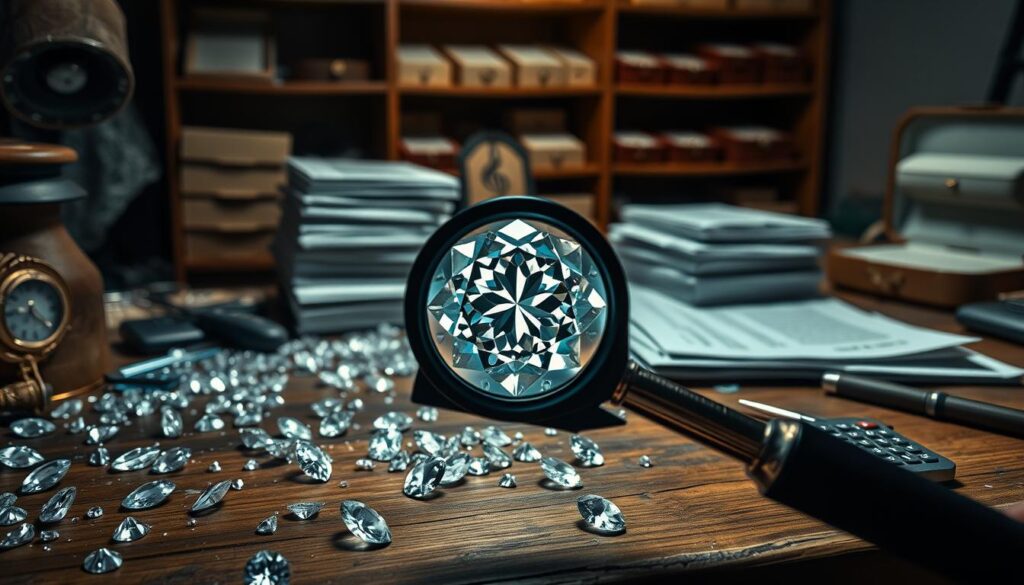
“80% of gemologists agree: a diamond’s cut is the most critical factor affecting its value.”
How to Buy Diamonds Wholesale Buying diamonds noncommercial allows you to buy exquisite diamonds at fair request rates. This process involves understanding diamond instruments, cuts, and noncommercial pricing to insure you make a smart investment.
- False “wholesale” claims: Sellers might say they sell wholesale but charge too much. Make sure they really work with the makers.
- Certification shortcuts: Diamonds without GIA or IGI reports might have hidden problems. 50% of buyers don’t check, which can cost them too much.
- Cut quality neglect: A bad cut can make a diamond look 50% dimmer than a perfect one. Always check the cut grade first.
- Rushing decisions: 90% of first-time buyers wish they had thought more before buying. Always ask to see the diamond in person or get a clear video.
| Pitfall | Fix Strategy |
|---|---|
| Unverified clarity grades | Request microscopic imaging for SI1+ clarity grades |
| Overlooking certification labs | Stick to GIA/IGI reports only |
| Ignoring payment security | Use escrow services for transactions over $5k |
Remember wholesale diamond purchasing tips like making sure the diamond is graded by someone else. If a seller is not clear about where they get their diamonds, that’s a big warning.
How to Buy Diamonds Wholesale Learning the stylish practices for buying diamonds noncommercial can help you secure better deals on high- value monuments. With noncommercial buying, you skip retail cheapies and get near to true diamond value.
Always ask for lab reports and check the cut—80% of gemologists say cut is the most important. By avoiding these mistakes, you’ll buy diamonds wholesale with confidence.
Best Practices for Wholesale Diamond Purchases
Learning the best practices for wholesale diamond purchases helps keep your money safe. It also builds trust over time. A good wholesale diamond buying guide includes detailed records and safe storage. Here’s how to do it right:
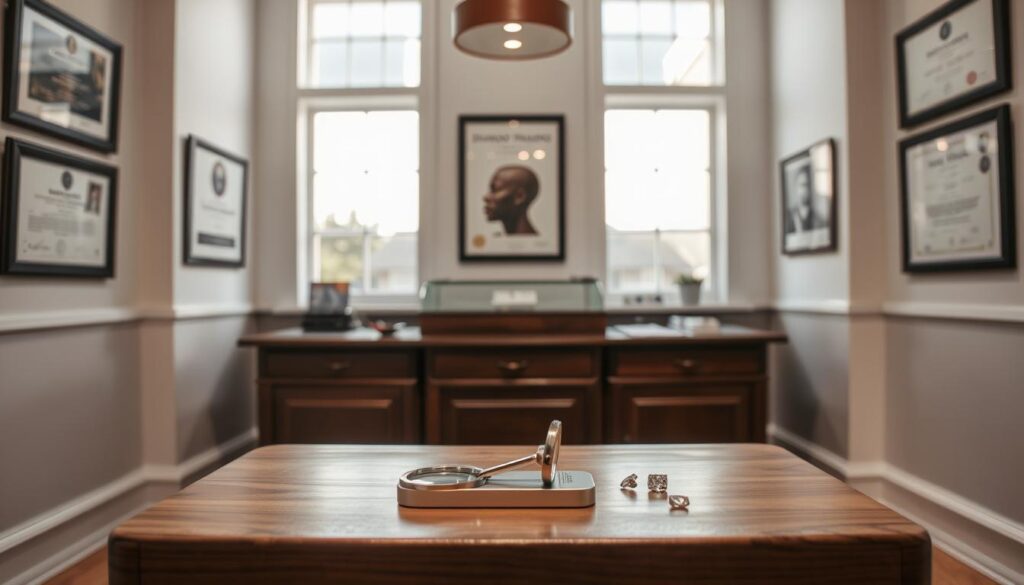
“When you buy a GIA certified diamond, you have the confidence of knowing exactly what you are buying…”
How to Buy Diamonds Wholesale Wholesale diamond purchasing gives buyers the occasion to pierce decoration diamonds at reduced costs. By sourcing from pukka wholesalers, you can get superior quality without overpaying.
Documentation is key. Keep GIA certificates, invoices, and clear photos of each diamond. Store these digitally and in hard copies. For big purchases, use spreadsheets to track details like cut and clarity.
- Insurance: Get policies for jewelry that cover theft, damage, and loss. Make sure they match today’s values.
- Transport: Ship with carriers like FedEx or DHL. Say the package is “gemstones” and track it well.
- Testing: Check for symmetry and shine with 10x loupes. Labs like EGL or IGI can tell if it’s real or fake.
Store diamonds in foam-lined boxes to avoid scratches. Update appraised values yearly with RapNet. This helps adjust prices. Buying in bulk can save up to 15% if you spend at least $5,000. Focus on clarity: VVS and VS grades keep their value better than lower grades.
Conclusion: Mastering the Art of Wholesale Diamond Buying
With this wholesale diamond buying guide, you’re set to tackle the diamond market. Focus on the 4Cs and look for GIA certifications. This ensures quality and value. Companies like Shane Co. show how important ethical sourcing is.
They have over 90 years of experience. They offer hand-selected diamonds and a lifetime warranty. This shows even individual buyers can get great deals by making smart choices.
Lab-grown diamonds are gaining popularity, making up 15% of the market. They cost up to 40% less than mined diamonds. Their production, like CVD technology, is ethical and saves money while being good for the planet.
Online platforms and direct suppliers help avoid high prices. Small changes in color or clarity can greatly affect price. So, check grading reports carefully. How to buy diamonds Wholesale Knowing how to buy diamonds noncommercial can transfigure your purchasing experience. From navigating pricing to vindicating instruments, noncommercial buying offers a cost-effective way to enjoy beautiful, foamy diamonds
The diamond market is moving towards being more open. Lab-grown diamonds are growing fast, and ethical sourcing is key. Buyers at any level can ask for clear information.
Whether you’re starting a jewelry business or buying a big diamond, this guide helps. It ensures you pay the right price and get quality gems. The main thing is to stay informed, check certifications, and choose suppliers who value honesty.
FAQ
Source Links
- Wholesale Diamonds | Diamond Trade-In –
- https://www.lumeradiamonds.com/buying-diamonds/wholesale-diamonds?srsltid=AfmBOooit24EtI2TUGFsb85P_BSL_ZLAfZ_y2zYqNqj89iybmIz2fJ4b
- Loose Wholesale Diamonds: How to Buy? –
- https://www.petragems.com/education/buying-wholesale-diamonds/
- How to Buy a Diamond Wholesale: Find Certified Diamond Wholesale Distributor – RRP Diamonds –
- https://www.rrpdiamonds.com/buying-certified-wholesale-diamonds-guide/?srsltid=AfmBOooNYljeP_OeEU6SQHY73_4bQJV9ysyOnmtLuPd2sHynBRmRSMJ1
- 5 Reasons to Buy Diamonds at Wholesale Prices –
- https://shira-diamonds.com/buy-diamonds-at-wholesale-prices/
- The 9-Step Guide to Buying a Diamond –
- https://www.diamonds.pro/education/diamond-buying-guide/
- Wholesale Diamonds | Diamond Trade-In –
- https://www.lumeradiamonds.com/buying-diamonds/wholesale-diamonds?srsltid=AfmBOoq2PM7VpTLWh14WMKam_MSoOQHwA6WpiQMKFb3K1AuUUEN4hg-_
- Insider’s Guide to Wholesale Diamond Buying –
- https://www.brilliyond.com/blog/guide-to-buying-diamonds-wholesale-from-selection-to-purchase
- Buy Diamonds at Wholesale Prices – #1 Diamond Seller –
- https://www.israel-diamonds.com/search/diamonds/default.aspx
- Wholesale Diamonds | Diamond Trade-In –
- https://www.lumeradiamonds.com/buying-diamonds/wholesale-diamonds?srsltid=AfmBOoqYYtLZc5OWoauXWHM3JO96_4N39sDT9xbSg76lX_TVDiUqg-FR
- How to Buy a Diamond Wholesale: Find Certified Diamond Wholesale Distributor – RRP Diamonds –
- https://www.rrpdiamonds.com/buying-certified-wholesale-diamonds-guide/?srsltid=AfmBOoqcsFGP-pzJjyyEqxta8vm_OcgVzket5ww2zDgwhxyUumQaQsFy
- San Diego Diamond Buying Guide –
- https://www.diamonds.pro/reviews/san-diego-diamond-buying-guide/
- How to Buy a Diamond Wholesale: Find Certified Diamond Wholesale Distributor – RRP Diamonds –
- https://www.rrpdiamonds.com/buying-certified-wholesale-diamonds-guide/?srsltid=AfmBOorqYKBNsnNMbGzgnzp_ZJElW9nRg0r2J5QmRJTjC3AoOGpL51gV
- A Guide to Ethical Diamond Buying –
- https://www.diamonds.pro/education/ethical-diamonds-conscientious-consumers-need-know/
- Mistakes To Avoid When Shopping For Diamonds –
- https://www.flawlessfinejewelry.com/the-journal/buying-guides/mistakes-to-avoid-when-shopping-for-diamonds/
- Top 10 Diamond Buying Mistakes –
- https://www.queensmith.co.uk/journal/top-10-diamond-buying-mistakes
- How to Buy a Diamond Wholesale: Find Certified Diamond Wholesale Distributor – RRP Diamonds –
- https://www.rrpdiamonds.com/buying-certified-wholesale-diamonds-guide/?srsltid=AfmBOooNO6vHUXBIVHtBb3oKM-wFIcboUE1L9rbHXNPLDJxcqQfytKU6
